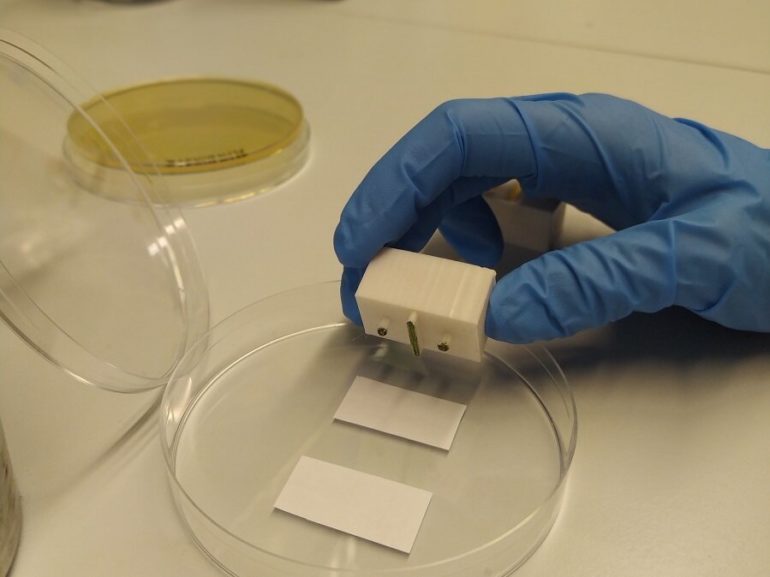The Research Group on Synthetic Biology for Biomedical Applications at Pompeu Fabra University in Barcelona, Spain, has designed a cellular device capable of computing by printing cells on paper. For the first time, they have developed a living device that could be used outside the laboratory without a specialist, and it could be produced on an industrial scale at low cost. The study is published in Nature Communications and was carried out by Sira Mogas-Díez, Eva Gonzalez-Flo and Javier Macía.
We currently have many electronic devices available to us such as computers and tablets whose computing power is highly efficient. But, despite their power, they are very limited devices for detecting biological markers, such as those that indicate the presence of a disease. For this reason, a few years ago ‘biological computers’ began to be developed—in other words, living cellular devices that can detect multiple markers and generate complex responses. In them, the researchers leverage biological receptors that allow detecting exogenous signals and, by means of synthetic biology, modify them to emit a response in accordance with the information they detect.
So far, cellular devices have been developed that must operate in the laboratory, for a limited time, under specific conditions, and must be handled by a specialist in molecular biology. Now, a team of researchers from Pompeu Fabra University has developed new technology to ‘print’ cellular devices on paper that can be used outside the laboratory.
Interestingly, they use ‘ink’ of different cell types with nutrients to ‘draw’ the circuits. The cells remain trapped in the paper, alive and functional, and there, they continue growing and are able to release signals that travel through the paper and reach other cells. The reason for doing this on paper (or other surfaces such as fabrics) is principally practical; it is cheap and easy to adapt to industrial use, and large quantities could be produced at a very low cost. “We wanted to design a scalable model and we thought about using a printing system like the one for printing T-shirts,” details Sira Mogas-Díez, first author of the study. “We make molds with our drawing, we soak it with the different cellular inks like a buffer, put it on paper and the cells are deposited,” she adds. One strong point is that these devices on paper can be kept in the refrigerator or can even be frozen, since the cellular ink incorporates cryoprotectors that so permit. Thus, unlike previous devices, they can be stored for long periods of time before use.
In this new approach, each element of the device is a group of cells, in this case bacteria, with minimal genetic modifications that can detect different signals. The cells live in the strip of paper and communicate with each other, integrate signals and generate one response or another depending on the different combinations of signals detected. The elements do not vary, but changing their arrangement in space by means of the drawing they make on paper, devices can be built with different functionalities. “Therefore, the order in which the cells are placed is the software, the cells are the hardware, and the paper is the physical substrate hosting these cells,” Javier Macía, coordinator of the work, illustrates.
The research team has designed various biosensors, one with a specific application to detect mercury. The system’s contribution compared to other existing ones is that it makes a visual estimate of the concentration of mercury without requiring a device in the laboratory that measures it. Depending on the amount of mercury present, more or less dots appear on the reactive strip that can be counted with the naked eye.
Another application being developed is based on detecting cholera in polluted water. “Settlements where there is a risk of cholera often do not have a laboratory or a specialist. Hence, our idea was to develop a new method that would allow us to get living technology outside the laboratory and use it in the field. Our approach is interesting to tackle this kind of problem because it is inexpensive and enables the production of cellular devices in industrial quantities,” Sira explains.
Another potential use would be to identify, for example, the risk of preeclampsia. Its detection depends not only on a single marker but a complex combination of markers. A strip with the cellular device with the appropriate configuration could detect biomarker combinations, analyze them and determine a pregnant woman’s risk of suffering from this disease.
“Certainly there is much work to do, but these initial results suggest that the methodology developed may be the means to facilitate the creation of commercial products based on living devices,” Javier Macía concludes.
The optimal design of cellular sensing systems
More information:
Sira Mogas-Díez et al, 2D printed multicellular devices performing digital and analogue computation, Nature Communications (2021). DOI: 10.1038/s41467-021-21967-x
Provided by
Universitat Pompeu Fabra – Barcelona
Citation:
Researchers design a biological device capable of computing by printing cells on paper (2021, March 19)
retrieved 19 March 2021
from https://phys.org/news/2021-03-biological-device-capable-cells-paper.html
This document is subject to copyright. Apart from any fair dealing for the purpose of private study or research, no
part may be reproduced without the written permission. The content is provided for information purposes only.



